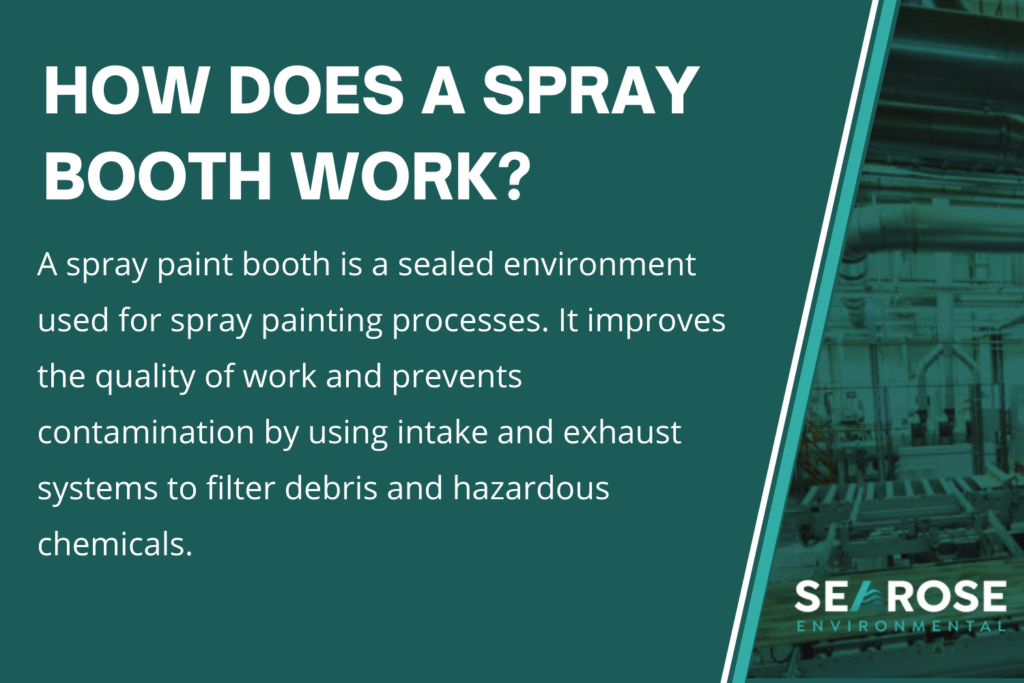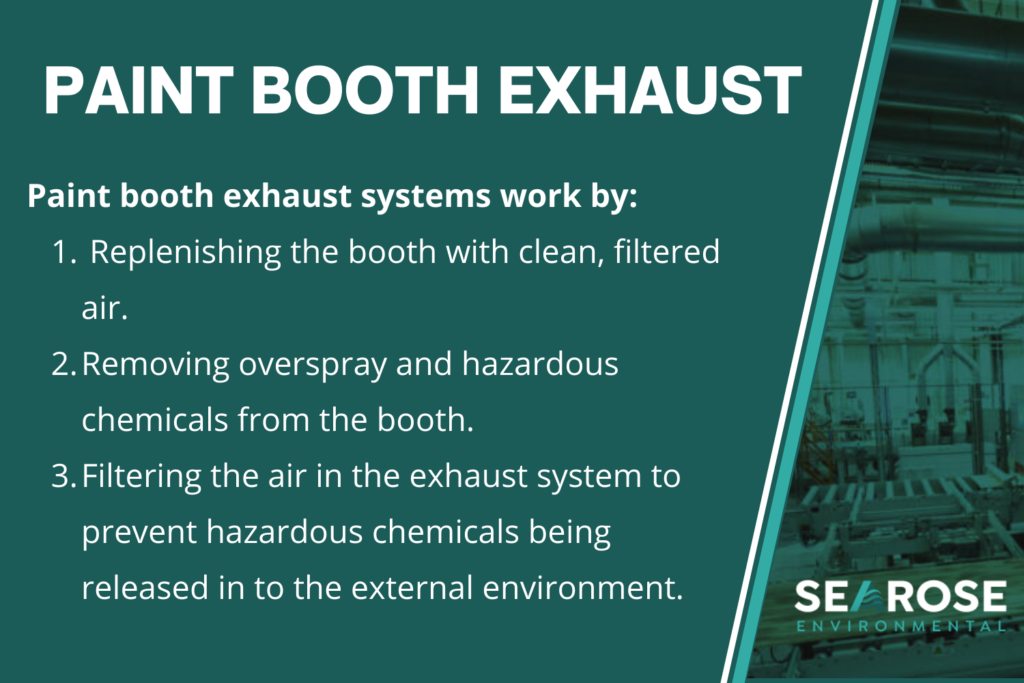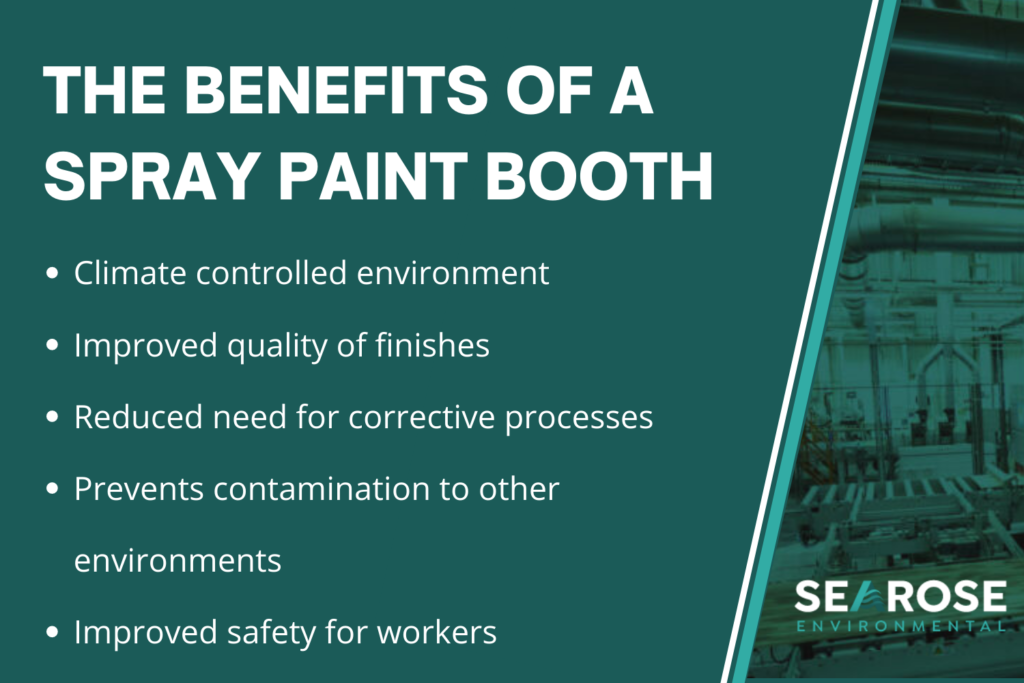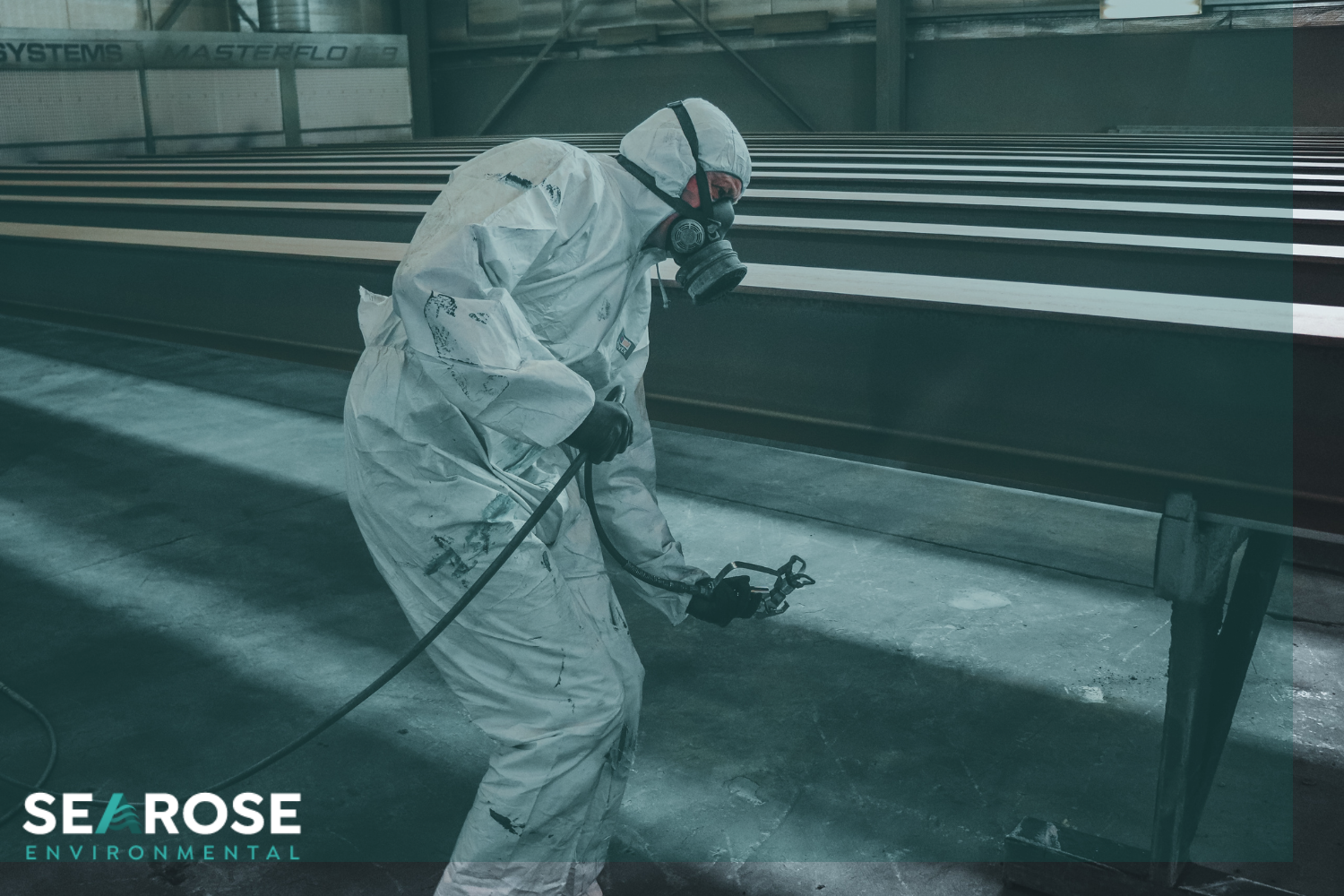Whether you are a hobby painter or aircraft manufacturer, you will have required the use of a spray paint booth. So, how does a spray booth work?
Well, spray paint booths provide a controlled environment for high-quality paint application and safer working conditions. There are also paint booth exhaust air flow requirements and paint booth filtration requirements to ensure maximum efficiency and safety – more on that later.
As Brisbane’s leading spray paint booth installers, Searose Environmental are the experts when it comes to the functionalities of spray booths. Within this article, we’re going to breakdown how they work, the filtration and exhaust requirements, and where they might be used. Let’s start with the basics:
How Does a Spray Booth Work?
In brief, spray-paint booths work to contain airborne particles and dust within the painting area. The booth creates a sealed environment that allows individuals to maintain clean working conditions for better spray finishes. The controlled environment also helps reduce the spread of contamination to other working areas using exhaust fans and filters. Containing particles and contamination within the sealed environment creates a more suitable spray-painting environment and improves the quality of work for all.

As spray booths prevent solvents and other hazardous material from contaminating the rest of the shop but do not protect the worker inside it, workers must wear protective equipment. A worker will utilise respiratory devices and personal protective equipment to ensure they operate according to appropriate safety regulations. This includes wearing chemical resistant protective gloves and using supplied-air respirators.
How Does a Spray Booth Work To Reduce Cost?
A spray booth can be utilised as a modular or stand-alone system. It is used to improve the quality of spray paint finishes in various industries. By increasing the spray finish quality, manufacturers can reduce their costs by avoiding additional processes such as buffing, sanding, and other corrective procedures. As a spray paint booth provides a controlled area, filtration and an easy to clean workspace, spray booths are used in several industries, including:
- Aerospace Manufacturing
- Vehicle Manufacturing
- Ship Building
- Engineering
- Fabrication
- Vehicle Maintenance
Paint Booth Exhaust Air Flow Requirements
An exhaust fan draws air out of the booth, removing air contaminated with particles and overspray. As the contaminated air exits the booth via the exhaust, it passes through a filter that collects the excess particles and contaminants. The exhaust fan and filters keep air pollutants within a safe level and prevent contaminants from spreading to working areas outside the booth. The exhaust fans are situated in what is known as an exhaust plenum. This is a chamber in which the fans and filter are connected to external ducting.

Types of Spray Paint Booths
Downdraft: Often considered the best method of removing overspray, a downdraft paint booth pushes air in from the top of the booth and moves it down and around the object below. The exhaust fans are situated on the floor of the booth or pit beneath the part and pull air and overspray down away from the part, and the worker
Semi-Downdraft: Semi-downdraft booths operate in a similar fashion to downdraft booths, with air coming down from the ceiling. However, the exhaust vents are located in the corners, instead of being situated directly beneath the part. A semi-downdraft configuration would be used over a downdraft design in booths where a pit is not feasible.
Cross-Draft: “How does a spray booth work with a cross draft?” you may be wondering. Well,Instead of air moving from top to bottom, cross draft configurations use horizontal airflow with intake and exhaust fans located on the walls. The air moves from the front to the back and is a low-cost option where it is not possible to have a pit.
While these configurations cater to specific situations, they can be further customised with lighting, observation windows, controls panels, fan assemblies and air heaters to provide a tailored solution for every organisation. If you would like to consult with a team of experts for Spray Booth Installation, Searose Environmental offer tailored solutions for spray paint booths across various industries.
Paint Booth Exhaust Duct Requirements
When configuring a spray paint booth, it is not as simple as throwing in several fans and turning them on. There are paint booth exhaust duct requirements to ensure the correct flow of air and efficient extractions of overspray and pollutants. To create a suitable environment within the spray booth, both exhaust and intake fans must be working together.
When the exhaust fan is on, the booth has negative air pressure due to more air being removed than entering. When there is negative pressure and the entry to the booth is open, it will pull in as much air as possible, including dirt and debris. If only the intake fan is on, there will be negative pressure and the reverse will happen. The positive air pressure will push air out of the booth as the door is opened, including dirt and debris. Often, manufacturers opt for a slightly positive air pressure to reduce dirt and debris from entering the spray booth chamber.
Paint Booth Filtration Requirements
Just like the paint booth exhaust duct requirements, there are also paint booth filtration requirements. Filters ensure that the air entering the spray booth is free of any dirt and debris and the air exiting is free of any hazardous chemicals. Filters are not only used for the intake and exhaust; they are also used to ensure clean air is travelling through the spray hoses.
Over time, filters will become clogged with debris, and their efficiency will be reduced. Clogged filters will eventually affect the airflow inside the booth and result in dust and overspray. While the cycle for changing and replacing filters depends on the type of booth, exhaust configuration and air quality of the local environment, it is advisable to change your filters as soon as you notice a drop in performance. You can set conditions for replacing your filters using a Manometer or Velocity Meter.
Parts of a Spray Booth
When asking, “How Does a Spray Booth Work?”, it is crucial to not only understand the filters and exhaust systems, but also the other parts that make up a spray booth.
Paint Booth Walls – Paint booth walls are available in single and dual skin designs. Walls can also be coated in white to increase the reflectability of light, so it is easier to see what you are painting.
Paint Booth Doors – Paint booth doors provide entry and exit points for parts and vehicles while maintaining a pressurised seal if needed.
Air Makeup Unit – An air makeup unit helps maintain suitable pressure levels in the exterior and interior of the booth by interacting with both the intake and exhaust systems. If air cannot be directly pulled from the building, it can be pulled in and filtered through an AMU.
The Benefits of Using a Spray Booth
As spray booths create a sealed and contained environment, it is much easier to control the conditions within the area. Overall, this increases the efficiency and safety of spray painting related processes.

Spray booths also provide an easy to clean and maintain solution. This is true within the controlled workspace and reduces the contamination and spread of particles to working spaces outside the booth. Better containment of pollutants and debris reduces the cleaning requirements for these workspaces, improving the general safety of the whole area.
Tips for Using a Spray Booth
While it is essential to know how does a spray booth work, there are also some things you should know when working in a spray booth. What is a paint booth without skilled technicians to operate them, right?
The first and most important rule is to never remove your personal protective or respiratory equipment until you have left the booth. Removing your PPE inside the booth could expose your body to the hazardous chemicals used in the spraying process.
Additionally, you should always check if the booth is operating correctly. Check the air pressure gauge on the control panel and ensure it aligns with the manufacturer’s guidelines. You should also get into the habit of checking your filters and changing them regularly.
Before you spray, you should always position yourself closer to the air intake than the spray gun. Correct positioning will ensure that any overspray is carried into the exhaust and away from you, and a better finish is achieved.
Overspray is the excess paint that comes out of the hose and can interfere with the overall finish of the spray-painting job. Three tips to minimise overspray include:
- Keep the spray gun perpendicular to the surface being coated
- Spray from a distance of about 15cm
- Use a high-volume, low-pressure spray gun
Choose Searose for Your Spray Paint Booths
If you are looking for the best Spray Booths in Australia, look no further than Searose Environmental. At Searose, we have the leading range of spray booths and provide expert Spray Booth Installation. We provide booths to service all painting industries and comply with environmental, workplace, health, and safety requirements. For further consultation, call us today or submit an enquiry through our contact page.
